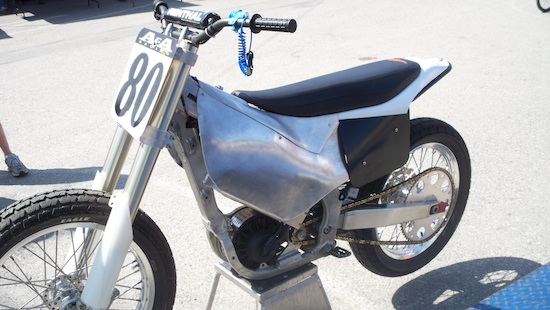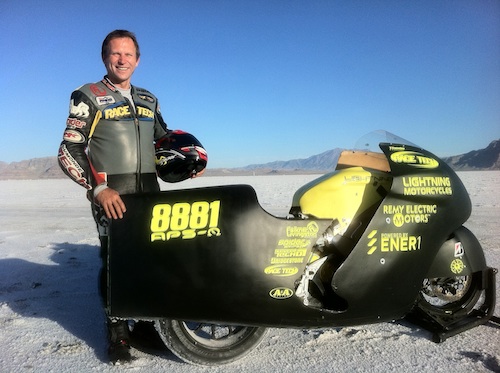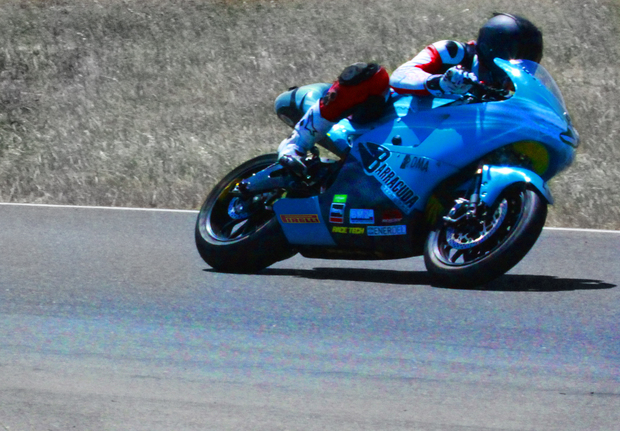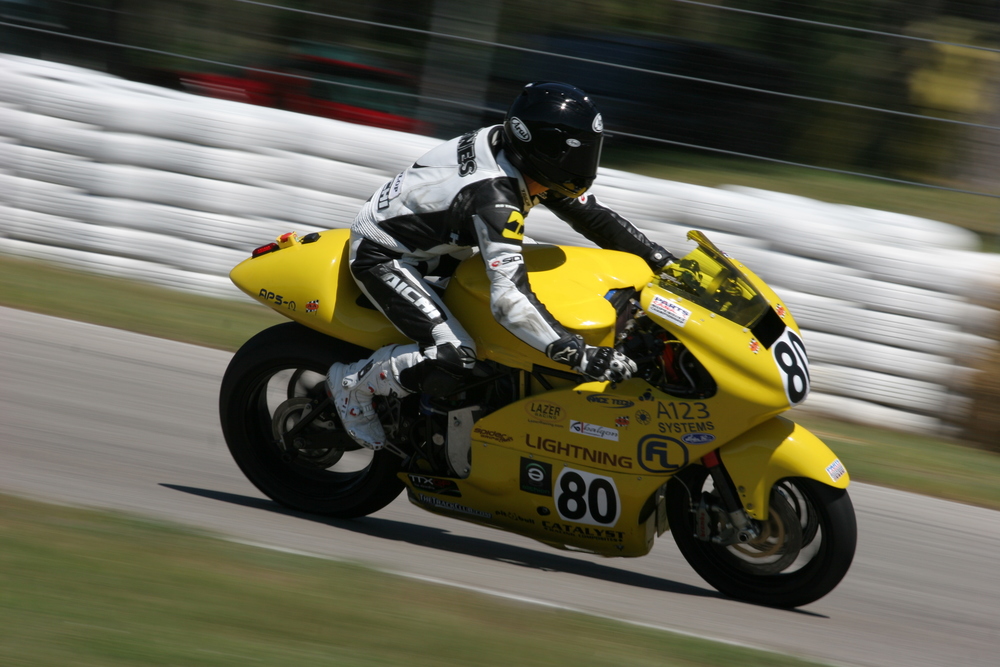I want the electric motorcycle industry to succeed if only because of the need to electrify every type of vehicle. My work has circled around the electric motorcycle industry for some time, and as a result I’ve met most of the movers in this industry. Having talked with Richard Hatfield, the CEO of Lightning Motorcycle, many times, I have grown more and more saddened with the news that is coming out about the company and its sales record.
Namely – there are claims that Lightning is not making many sales, and that potential sales partners were left feeling betrayed. Over the years I’ve known Richard Hatfield and Lightning Motorcycles, I’ve heard several troubling stories. I’ve also talked with Richard many times, and have gone to his house and the shop in San Carlos (they’ve since relocated to San Jose) several times. From what he’s told me of his history, Richard Hatfield has a clear passion for clean transportation, and proving clean transportation at race tracks. His track record in this area goes back over 20 years. But, Richard Hatfield set out to build a business selling electric motorcycles, and operating such a business means implementing a basic level of customer service, building a dealership network, and achieving production and sales volumes. The story going around currently is that Lightning Motorcycles is not succeeding at those things.
Attached at the bottom of this post is a video by an avid electric motorcycle fan who recorded a SCAM ALERT naming Lightning Motorcycles, and detailing some of the news that recently came up.
Brief history of Richard Hatfield and Lightning Motorcycles
Richard explained to me is that during the 1990’s there was an electric car racing series known as Formula Lightning. Richard was at the time a “race car driver” (I don’t remember if he explained that further, whether he was on a professional racing circuit, or whether he took cars to track days, or what) and was invited to drive one of the cars in that series.
At the time lead acid batteries was the name of the game. Another person I talked with about Formula Lightning described having gone to the battery testing laboratory for Trojan Batteries (an eminent lead acid battery maker) and how the ceiling of that lab was studded with lead rods from batteries that had blown up during testing. One of the vehicle types used in Formula Lightning used a system for quickly exchanging battery packs, so that a car could be out racing on the track while another battery pack was charging in the pits.
After racing in the Formula Lightning series, Richard Hatfield got involved with a racing effort powered by biofuels. He showed me a magazine article about this, if I recall correctly it happened in the early 00’s.
In May of 2007 Richard Hatfield and Todd Kolin unveiled the Lightning Lithium electric superbike. It was built on a Yamaha R1 chassis, had a massive Thundersky battery pack, and enough horsepower to properly burn rubber. The build was written up by the LA Times![]() and there was a YouTube video but that video appears to have disappeared.
and there was a YouTube video but that video appears to have disappeared.

In March 2010 Richard invited me to a “flat track” race event in San Jose, which I wrote up on VisForVoltage![]() . He’d built a bike – based on a Honda 450 chassis – for the event. It had what looks like an Agni motor and a battery pack tucked inside the frame. The race format was a small oval track, about 3 laps. There were several electric motorcycles present for what was billed to me as a historic event, the first time any electric motorcycle participated in such a race.
. He’d built a bike – based on a Honda 450 chassis – for the event. It had what looks like an Agni motor and a battery pack tucked inside the frame. The race format was a small oval track, about 3 laps. There were several electric motorcycles present for what was billed to me as a historic event, the first time any electric motorcycle participated in such a race.

By May 2010, the Lightning Motorcycles racing team caught a lot of attention with a banana-colored electric motorcycle powered by a motor salvaged from a GM EV1. If you studied the motor closely there was clearly a nameplate from General Motors, and the serial number matched up with one used in an EV1. Back in the Lightning shop in San Carlos they had another 5 of those motors, which I saw on one of my trips to the shop.
Between 2010 and 2013 Lightning dominated the electric motorcycle racing scene. They won almost every race they entered, and for most of those races their bike was powerful enough to lap the entire field. The only serious competition started in 2011 and 2012, first by MotoCzysz and later by Brammo.

Another area was land speed racing. They entered a race at the Bonneville Salt Flats every year, eventually setting a land speed record of 215 miles per hour average over two runs. The top speed achieved during that run was 218 miles/hr. By that time Lightning had graduated from the EV1-powered bike to a bike they’d designed themselves. That bike design is what became the LS-218 that Lightning has on sale today.
Another success was at the Pikes Peak International Hill Climb in 2013. With that same bike and rider Carlin Dunne, they beat the entire motorcycle field by over 20 seconds. That includes the 1300cc gas powered behemoths that normally win at Pikes Peak, all beaten by a huge margin by an electric motorcycle.
For the land speed records, and the Pikes Peak run, Richard Hatfield directly sent me text messages to my cell phone proclaiming the win, and immediately followed by another messaging saying that Lightning is now ready to start producing electric motorcycles for sale.

Lightning electric motorcycle design and manufacturing
Lightning Motorcycles always had the goal of selling a range of electric motorcycles. Richard liked to claim to be following the Tesla business plan, to start with a high end no holds barred electric motorcycle, and plow profits into designing and manufacturing ever-more-affordable electric motorcycles.
Over the years Richard showed me a few designs. One was a 45 miles/hr electric scooter with a 45 miles range that could have hit a sweet spot at the time he showed it to me. But it never went to production. Another was a street bike targeted for highway speed, but it too never went to production.
In November 2014, Lightning held an event in San Francisco touted as the first sale of an LS-218 to a paying customer. The event was at a space owned by AutoDesk (the maker of AutoCAD) in part because AutoDesk staff had played a role in helping Lighting with the design. However some people have told me this event was staged, and the customer was a member of Lightning’s Board of Directors.
After the Pikes Peak win, Lightning took a breather from their racing schedule to work on manufacturing and selling motorcycles. The adage is “Race on Sunday, Sell on Monday” which is what Lightning attempted to do.
It’s one thing to boast to a journalist (myself) that Lightning could start selling electric motorcycles having won a big race. It’s another thing to get the manufacturing, quality control, sales, distribution, marketing and service properly lined up. THAT is probably the hardest part of launching any business, much less breaking new ground as an electric motorcycle manufacturer.
As much as Richard’s team succeeded at the race track, rumors and murmuring persisted over the years that Lightning was not successfully selling electric motorcycles. As the presenter in the video below says, if there were paying customers for the LS-218 then why wouldn’t one have shown up at a race track, or posted to social media bragging about having bought one of these bikes and raving about how fun it is? No such postings exist, and nobody other than Lightning has brought an LS-218 to any race track.
UPDATE 1: Lightning did show pictures of a customer buying a Lightning Strike on September 8, 2019![]() . The video attached below does quibble over this posting because supposedly Lightning is working first on selling the Carbon series – the high end Lightning Strike model – before moving to the low-end series. However it’s clear from this picture the bike being purchased is not a Carbon model.
. The video attached below does quibble over this posting because supposedly Lightning is working first on selling the Carbon series – the high end Lightning Strike model – before moving to the low-end series. However it’s clear from this picture the bike being purchased is not a Carbon model.
UPDATE 2: There is a Facebook dedicated to Lightning Motorcycles![]() . In the group Sam Baker says there are two known sales of the LS-218, and one known sale of the Lightning Strike. Both the LS-218’s have been back in the shop repeatedly for repairs. There is a posting by Guido Seibt
. In the group Sam Baker says there are two known sales of the LS-218, and one known sale of the Lightning Strike. Both the LS-218’s have been back in the shop repeatedly for repairs. There is a posting by Guido Seibt![]() who owns an LS-218, but he says his is in the shop because it was hit by a car in traffic.
who owns an LS-218, but he says his is in the shop because it was hit by a car in traffic.
I did happen to see a Lightning LS-218 one day while driving in Santa Clara (where I live). Unfortunately we were in heavy commute-time traffic and were unable to get a picture of the bike. It was unmistakably an LS-218 but I did not see who the rider was. Presumably that means (unless it was Richard riding the bike) someone who uses San Tomas Expressway bought an LS-218 a couple years ago.
On the Lightning website today you’re offered the option to buy a Lightning LS-218, or to place a deposit on a Lightning Strike. The Strike is Lightning’s street bike (it’s a different street bike design than the one I was shown years ago) that is supposed to have an affordable price and is supposed to be produced in large quantity. The press release![]() announcing the Lightning Strike was issued in March 2019, showing a range of prices starting at $12000. But it’s 8 months later and the Lightning Strike is not on sale.
announcing the Lightning Strike was issued in March 2019, showing a range of prices starting at $12000. But it’s 8 months later and the Lightning Strike is not on sale.
A jilted potential dealer left feeling betrayed
In August 2019 a Facebook posting![]() by Kobus Jansen Rensburg tells a disturbing story. He is the owner of Electronia, a South African company that looks to be focused on selling electric powered products including electric vehicles.
by Kobus Jansen Rensburg tells a disturbing story. He is the owner of Electronia, a South African company that looks to be focused on selling electric powered products including electric vehicles.
Rensburg explains that he attempted to negotiate an International Dealership Agreement (IDA) with Lightning so he could sell LS-218’s in South Africa. However the deal turned out horribly wrong. The Facebook posting has lots of details, as well as scans of documents and other evidence. The short story smells like a scam, but of course we’re hearing just one side of the story. Rensburg paid out about $40,000 to get a bike he should show to potential customers, but Lightning never provided one, and ultimately ended up refunding to Rensburg a small portion of what Rensburg paid to Lightning.
After reading that posting back in August, I emailed the marketing address at Lightning for a response but never received an answer.
Very sad
I am very sad to have heard this information, to have seen the video below, and so forth. It should be clear that I have had a fairly good relationship with Richard Hatfield over the years, despite it being at least 2 years since I last talked with him.
The Richard Hatfield I know is passionate about electric motorcycles, and the potential for developing and proving technology at race tracks. But I’d heard a series of troubling stories about Richard over the years. Mr. Rensburg’s Facebook posting is the first of those I’ve seen with documentation. I believe there are other such stories others could tell, but I don’t know enough about those stories to relate them here.
However to tell this story of potential problems at Lightning Motorcycle, I have to tell the full range of information I have about Richard Hatfield and his company. This story goes back such a long way that I am having a hard time grasping that today’s Lightning Motorcycle could possibly be a scam operation. Why would someone spend over 20 years developing something just to pull a cheap scam for a few thousand dollars?
- Is there enough Grid Capacity for Hydrogen Fuel Cell or Battery Electric cars? - April 23, 2023
- Is Tesla finagling to grab federal NEVI dollars for Supercharger network? - November 15, 2022
- Tesla announces the North American Charging Standard charging connector - November 11, 2022
- Lightning Motorcycles adopts Silicon battery, 5 minute charge time gives 135 miles range - November 9, 2022
- Tesla Autopilot under US Dept of Transportation scrutiny - June 13, 2022
- Spectacular CNG bus fire misrepresented as EV bus fire - April 21, 2022
- Moldova, Ukraine, Georgia, Russia, and the European Energy Crisis - December 21, 2021
- Li-Bridge leading the USA across lithium battery chasm - October 29, 2021
- USA increasing domestic lithium battery research and manufacturing - October 28, 2021
- Electrify America building USA/Canada-wide EV charging network - October 27, 2021













